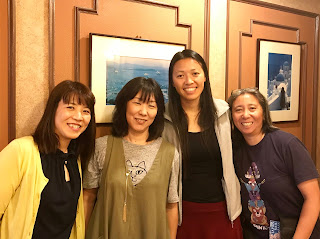【Report】 A junior high school teacher from California came to Japan for a survey
On 26th June, Takagi Foundation introduced you to be interested in the activity of the data site of everyone, and Cassandra Chen, a science teacher at a junior high school in Oakland, California and Candice Fukumoto-Dunham , a history teacher, said , “Asian As part of my research on citizen science, I came to see the Fukushima 30-Year Project, one of the executive groups, and the "Practical Team in Tokyo".
First, members of the Fukushima 30-year project met at Fukushima, and together they visited “Tarachine”, who also has a β-ray lab and clinic at a citizen measuring station, and also ran Route 6.
※ From the left: Tokyo Business-Nakamura, Executive Director-Koyama, Cassandra Chen , Candice Fukumoto-Dunham
In the United States, there is a problem of drinking water pollution by lead and other heavy metals, and it is said that junior high school students are conducting measurement survey of water pollution and heavy metal pollution.
In comparison, there was the question, "In Japan, for example, did the teacher measure the pollution of the school ground as a lesson with the children in the class after the accident?"
In Japan, I was surprised to tell that there is only a prescription for air dose, so there is a tendency to avoid the Becquerel measurement itself, and that if you try to do it at school you will not allow the Board of Education.
"What kind of thing that it is not allowed to check their own schools themselves?" I thought that the way after the Japanese accident from the world perspective seems strange.
On the other hand, at their school in California, it was felt that “civil science” had taken root in school education, and each teacher was carrying out classes and community activities from the perspective of a citizen scientist. In the specific interview, I was impressed to hear that you are investigating water and air pollution in cooperation with surrounding communities and universities.
The visits by these women were a few days fast, but I think that we could introduce the situation of the radioactive contamination and the activities for it densely, with Fukushima 30 years, Tachikan, Route 6, and Tokyo.
He stated, "We will bring back to the children and the community firmly and tell about the situation in Japan and what people in the Tohoku region are thinking about!"
He stated, "We will bring back to the children and the community firmly and tell about the situation in Japan and what people in the Tohoku region are thinking about!"
It was a good opportunity to investigate carefully and prepare many questions, and to know how we looked at our activities and stance from the outside and to think again. Above all, I was empowered by these young teachers being active.
If I had time, I would like to exchange more and more questions from each other.
With this kind of exchange, I wanted to deepen information exchange with overseas from now on.
Thank you very much Hirai-san of the Fukushima 30-year project for attending a car for two days in Fukushima and Tokyo and following up with a proper interpreter!
